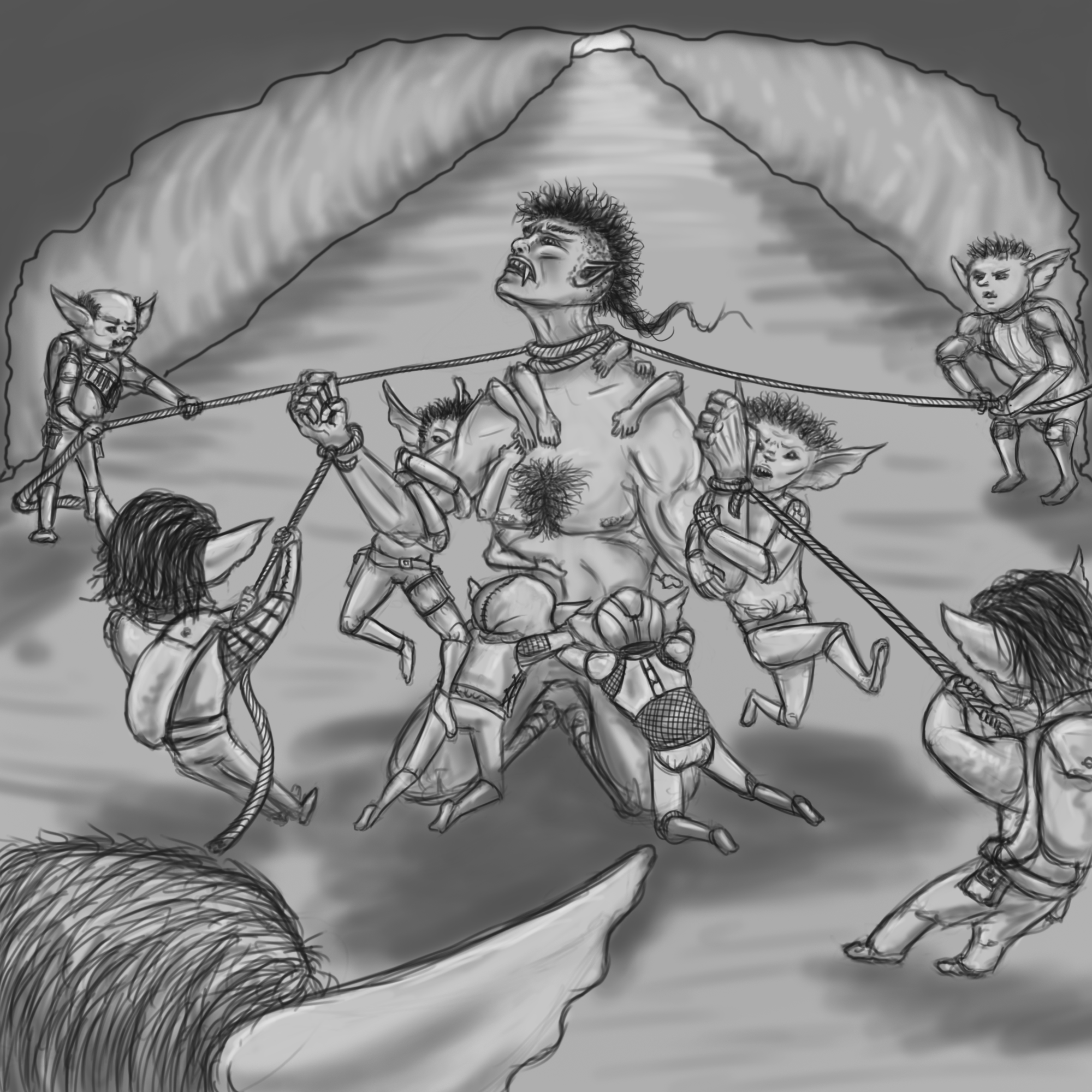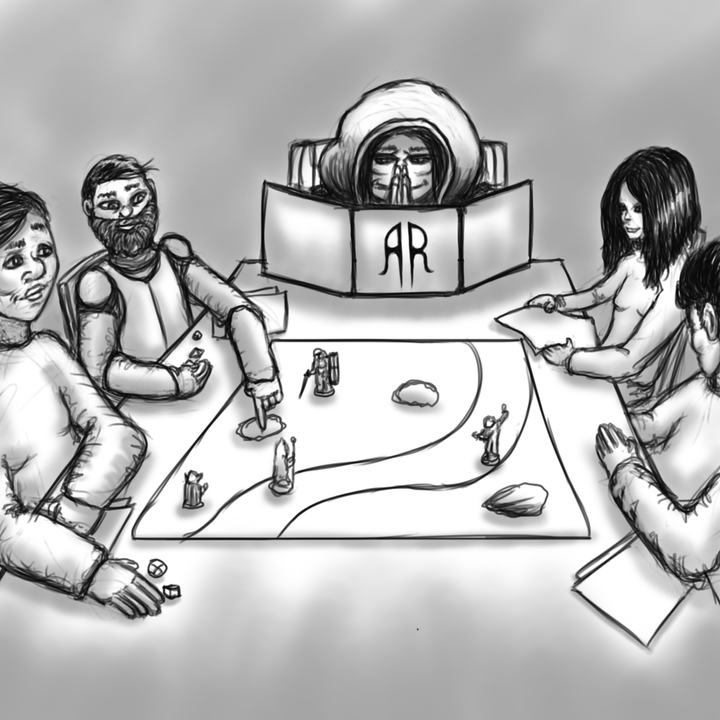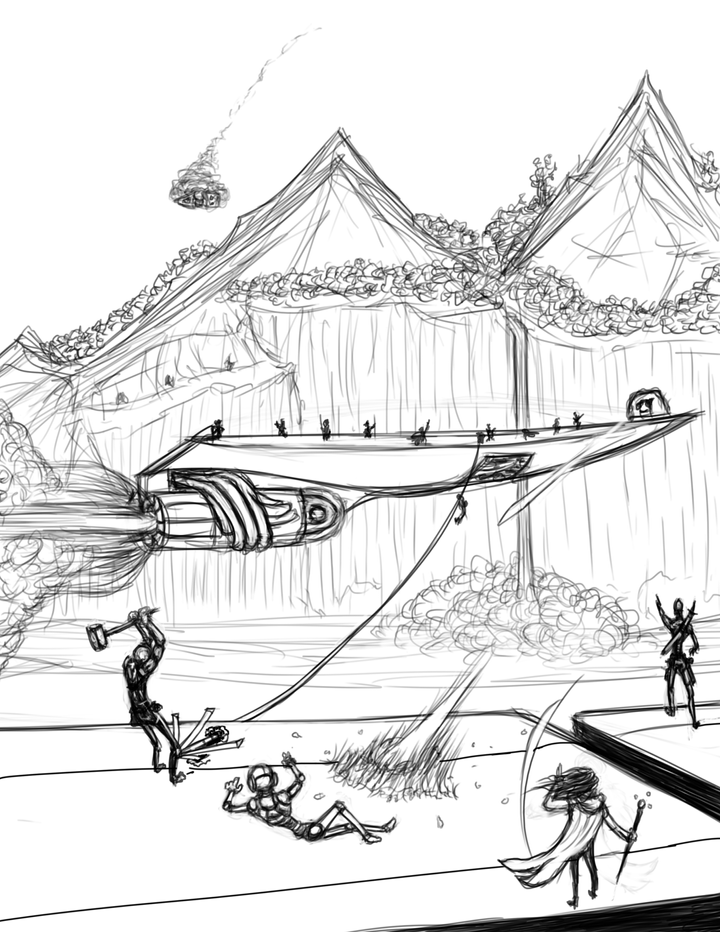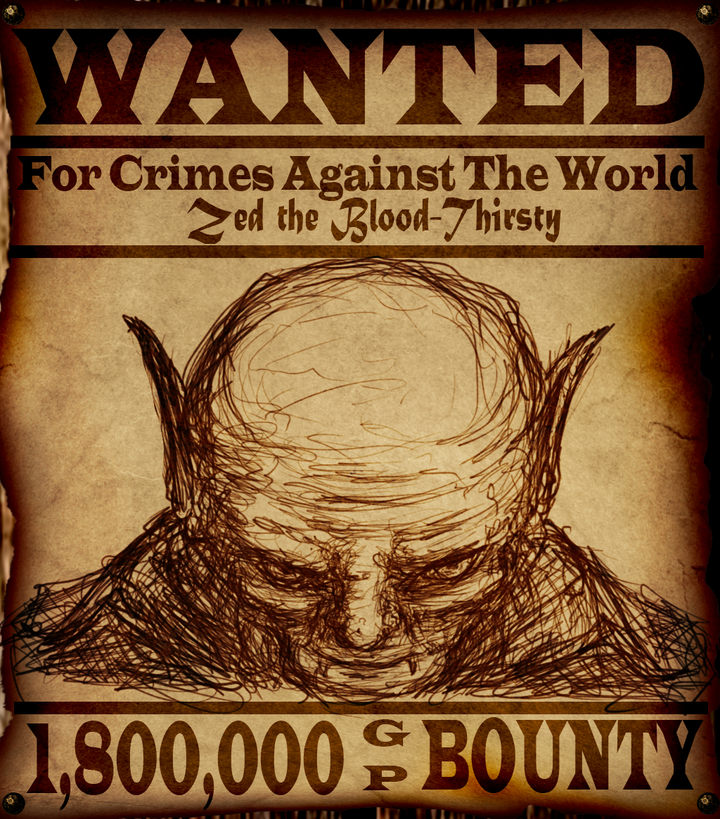Actions
Actions and the action economy are how all creatures interact with the game worlds of Altered Realms. Each turn taken by a creature is broken down into key characteristics of interaction. When starting a turn a typical creature has an Action, a Motion and a Movement available. When not currently taking their turn, creatures can use their Reaction(s) to utilize certain interactions. Particularly fast or well trained creatures can potentially gain access to additional Attacks, Movements or Motions.
Actions are how creatures perform complex or strenuous interactions with the game world such as attacks, spell casting and physical skill checks.
Motions are how creatures perform simple, swift and uncomplicated interactions with the game world, such as reaching for an item or weapon or drinking a potion on their person.
Movement enables creatures to interact with the game map and terrain. Movement is always used to cover distance or re-locate a creature. Each creature will have its move speed in meters listed on its character sheet or stat block along with its movement type.
Reaction(s) are how creatures respond to openings and hazards that occur off of their turn. Opportunity Attacks and all triggered abilities use a creature's reaction.
Action Economy Table
Each Action Type can be downgraded to a different action type on the fly during a turn. This only goes one way and any items, traits or abilities that grant additional Motions or Movement cannot be combined into additional Action(s). The following is a guide for how Actions can be broken down into other Actions of a Lower Type.
| Action Type | Downgrade |
|---|---|
| Action | Movement or 2 Motions |
| Movement | Motion |
Attack / Attacking / Attacks
Attacks are limited to any ability that is considered an Attack such as Melee, Ranged, and Spell Attacks. If your the goal of your action is to deal damage, then you most likely need to make an attack. Many skills and abilities grant you extra attacks in combat. While creatures may be granted multiple attacks, using any or all of them always utilizes your turn’s Action.
Aim / Aiming
Choose a target within range and expend 1 Ranged Attack Action to gain a +2 bonus to attack and damage roll on the next Ranged Attack vs the Aimed target until the end of your next turn. Aim can be taken multiple times as long as you have the Ranged Attack Actions to do so.
Carry / Carrying
A creature may carry other Willing, Restrained or Incapacitated creature(s) equal in size or smaller than themselves. The carrying creature must roll an Athletics Skill Roll in order to successfully lift and carry another. The DC is equal to 12 + the carried creature's CON Modifier and Increases by 2 for each creature currently being carried.
Recuperate / Recuperating
At any time, once per turn, a creature can spend their turn’s Action to convert 1 Attribute Resource Pool point in a single other ARP point (might, stamina, focus, brainstorm, willpower or panache).
Rally / Rallying
You can use a Full Round Action to Rally nearby allies that can hear or see you.
Roll a CHA based Skill Roll with a DC of 14. If you Pass, you allow allies within earshot to immediately make a Saving Throw with a +2 Bonus using their Reaction.
Inspire / Inspiring
You can use a Motion prior to making Attack Action(s) to get everyone's attention. Allies that can see you gain an Inspiration Bonus equal to +1 for each successful Hit promised. You have disadvantage on all attacks after you miss during this time. Usable only once between Resting periods.
A creature’s Inspiration Bonus can be spent once on any d20 roll before or after the roll has been made.
A creature can only have one Inspiration Bonus at a time and keeps the highest if they are granted another.
Sustain / Sustaining
Certain spells and abilities can be sustained for a resource pool reduction. When sustaining a spell or ability it is considered to be active as long as you have points available in the given resource pool. Each time a character sustains a new spell or ability they must reduce their Resource Pool Maximum by a number of points equal to the Sustain cost listed. If a creature ends their turn with a value 0 or less in the resource pool of a spell or ability they are currently sustaining, the effect is automatically and immediately ended.
Creature’s cannot Rest or Sleep while sustaining spells or abilities unless they have a trait, Item or ability that specifically allows its use during those states.
Prime / Priming
You can prime any Action to trigger off of your turn as a Reaction. You must state what Action you would like to prepare and what would trigger you to use said action. If you are preparing an attack action and have multiple reactions you may prepare as many Attack Actions as you have Reactions(most people have 1).
Targeting / Target
Any Creature can spend a Melee or Ranged Attack to target specific points on your target’s body* at any time. To do so, the creature must first specify which region of the body* you would like to target, Arm, Leg, Head, Torso etc. Then make an Attack Roll with one of the following modifiers.
As a rule Targeting a Body Part adds a -2 aim penalty to your Attack Roll and targeting a smaller region on that part increases the aim penalty to a maximum of -6.
For example: Targeting someone's arm would be -2 Aim penalty while targeting their hand would be a -4 and targeting their finger would be a -6. As the target gets smaller the difficulty to hit should increase. The same rule applies to weapons and held or equipped items. Attacking the item directly might only be a -2 penalty(depending on the size of the item) While targeting the strap or fastener that holds it should be a -4 or -6 depending on its size.
Sprint / Sprinting
You can spend your Action to gain an additional Movement this turn.
Each hour spent Sprinting requires the expenditure of 1 Stamina. Sprinting is impossible while at zero Stamina.
Dodge / Dodging
You can designate a particular target within line of sight that you wish to Dodge this round. You spend your Action this turn and gain Advantage on all Saving Throws caused by that creature’s Spells, Attacks or Abilities and that creature has a -2 Penalty on all Targeted Attack rolls vs you until the start of your next turn.
Charge / Charging / Rush
You can expend an Attack Action to make an enhanced Melee Attack at the end of a Movement. You must have at least 4 meters of unhindered space to move in a straight or diagonal line towards the target before rolling the Charge.
The Enhancement granted by a Charge is +2 to hit and damage. You can only gain the benefit of Charge once per Movement.

Grapple / Grapples / Grappling
With at least one Free Hand* any creature may use an Attack Action to attempt to Grapple a target creature within Melee Range. The target creature cannot be any larger than 1 size category larger than the Initiator.
Grapple When initiating a grapple, make an Attack Roll, If you are Wielding a Grapple Weapon you may Add your Training Modifier to the Attack Roll Modifier. Otherwise add the grappling creatures Strength or Dexterity Modifier to the Attack Roll Modifier.
Grappling If the Grappling Creature Hits it forgoes any damage for that attack and instead is considered to have Grappled that Creature. If the Grappling Creature wishes to grapple a specific part of the target they may do so, as if it was a Targeted Attack(apply a negative modifier to the attack roll, the smaller the target). If the Attack Hits, they are considered to have grappled the specific appendage or limb and it cannot be used until the grapple is broken, in addition to the standard effects of a grapple.
While using a Free Hand to Grapple an opponent, the grappling hand cannot be used to Wield Weapons or perform Actions/Motions other than Melee and Spell Attacks that target the grappled creature.
Grappled When a creature is grappled it cannot utilize its movement(except teleports) and during each of their turns that they remain grappled, they can use Attacks vs Creature's within Range as normal or use their Action to attempt to escape the grapple. When a grappled creature uses their Action to attempt to escape a grapple they roll a Strength or Dexterity Saving Throw. The DC is equal to the Grappling Creature's Maneuver Save DC. If they meet or exceed the DC they escape and break all grapples on them. If they fail to meet the DC they remain grappled.
Dog Piles Each additional creature that grapples the same creature instead of adding a new DC to be beaten by the grappled creature, instead adds 2 to the original DC to break the Grapple.
Breaking Grapples A grapple can also be ended by Wounding the Grappler's Limb, Slaying the Grappler, Incapacitating the Grappler or Restraining the Grappler. The Grappler may also choose to end the grapple at any time at no action cost during their turn and as a Reaction when it is not their turn.
No creature can grapple more creatures/limbs than it has "Free Hands"(grasping appendages).
Grappling Larger Creatures A grappler may target the large or smaller Limb, Appendage or Digit of a creature much larger than themselves. If they are successful, instead of hindering the creature's movement, they are considered to restrain the grappled limb, appendage or digit until the grapple is broken. In addition the grappling creature is considered to be attached to the grappled creature and moves with them wherever they go until the grapple is broken.
*Free hands can be any sufficiently strong grasping appendage with no item currently equipped.
Meat Shield
When a creature has another creature Grappled and they are targeted by a Ranged or Melee Targeted Attack they can, as a Reaction, Roll an Athletics or Acrobatics Skill Roll that Meets or Exceeds the Attack Roll to cause the creature they currently have grappled to be Hit by the Attack, rather than themselves.
Donning and Doffing Armor
Each set of armor has different amounts of time they require to take on and off. Armor Item Stat Blocks will have a Don/Doff time listed. Lighter armors have shorter times and heavier armors have longer times.
Push / Pull / Drag
With at least one Free Hand* Use an Attack Action to Push, Pull or Drag a target within melee range. The target creature cannot be larger than 1 size category larger than the Initiator. When initiating a Push, Pull or Drag, Roll a Melee Attack Roll. If you Hit, Forgo any damage and instead you may push, pull or drag the target a number of Meters equal to half your Strength or Dexterity Modifier(minimum of 1 Meter).
Dragging If the target is currently grappled then when they are pushed, pulled or dragged, the grappler may choose to move with the target, so long as they have the movement to do so.
Trip / Tripping
A creature may use an Attack Action to attempt to Trip a target within melee range. The target creature cannot be larger than 1 size category larger than the Initiator. When initiating a Trip, make an Attack Roll. If you Hit, Forgo any Damage and instead you knock the target Prone.
Throwing Objects
You can use your Action to throw any object or item. Tiny to Medium Items can be thrown with One Free Hand, anything larger requires two.
You can reliably and accurately throw an object a number of Meters equal to 1 + your STR or DEX Modifier. Creatures can use their Reaction(s) to Catch thrown items within 1 Meter of their location.
Creatures can Toss something to one another using a Motion as long as they are are within 5 meters of each other. Creatures can use their Reaction(s) to catch Tossed items.
Throwing objects long distances is possible but requires an accompanying Athletics or Acrobatics Skill Roll. Use the Table below to establish a DC.
| Distance | DC | Miss Effect |
|---|---|---|
| 6-10 Meters | 10 | The object lands in a random space, chosen by the narrator, within 1 Meter of the target. |
| 11-20 Meters | 12 | The object lands in a random space, chosen by the narrator, within 2 Meters of the target. |
| 21-30 Meters | 14 | The object lands in a random space, chosen by the narrator, within 4 Meters of the target. |
| 31-40 Meters | 16 | The object lands in a random space, chosen by the narrator, within 6 Meters of the target. |
| 41-50 Meters | 18 | The object lands in a random space, chosen by the narrator, within 8 Meters of the target. |
| 51-80 Meters | 20 | The object lands in a random space, chosen by the narrator, within 10 Meters of the target. |
| 81-100 Meters | 22 | The object lands in a random space, chosen by the narrator, within 12 Meters of the target. |
| 101-120 Meters | 24 | The object lands in a random space, chosen by the narrator, within 14 Meters of the target. |
| 121-150 Meters | 26 | The object lands in a random space, chosen by the narrator, within 16 Meters of the target. |
| 151-180 Meters | 28 | The object lands in a random space, chosen by the narrator, within 18 Meters of the target. |
| 181-200 Meters | 30 | The object lands in a random space, chosen by the narrator, within 20 Meters of the target. |
If you are attempting to target and damage a creature by throwing an object, see Improvised Weapons.
Throwing Opponents
While you have an opponent no more than 1 size category larger than you grappled, you may use an Attack Action to attempt to Throw the grappled target.
When initiating a Throw, Roll a Melee Attack Roll. If you Hit, Forgo any damage and instead you may Throw the target a number of Meters equal to your Strength or Dexterity Modifier(minimum of 1 Meter).
The thrown creature is considered to be dealt 1-3d8(depending on creature size) Blunt Damage.
Creatures can avoid the thrown creature and damage equal to the damage dealt to the thrown creature by passing a DC 11 + creature size category, Dexterity Saving throw. Larger creatures occupy more space are considered to be larger projectiles when thrown.
Stow / Sheathe / Pocket
Putting an item back in its pouch pocket or holster requires a Motion.
Drop / Let Go / Release
Dropping a currently held item on the ground does not require an action.
Equip / Draw / Wield / Hold
Drawing an item from its pouch pocket or holster requires a Motion, as does picking up medium or smaller items within melee range from the environment.
Rummage
Equipping an item from your pack or any non pouch, pocket or holster slot on your person is considered to be Rummaging and requires an Action to Find and Equip the Desired Item.
Defensive Stance
Use your Action and Movement to gain +4 to AC and add a Destiny Die on all Saving Throws made to Avoid Damage until the Start of your Next Turn.
Lend Aid
Use an Action or Reaction to lend aid to another creature within melee range currently making or about to make any skill roll in which you also have training.
Help DC: If you Roll a 12 or higher using the same skill as the skill roll being rolled then add 2 or that creature's skill Roll.
Hinder: I you Roll a 11 or lower using the same skill as the skill check being rolled then you apply -2 to that creature's skill Roll.
Motions
Motions are how creatures perform simple, swift and uncomplicated interactions with the game world.
grabbing a potion off a belt pouch, drawing a holstered weapon and tossing something to someone within 5 meters of you are all considered Motions.
Reactions
Reactions are how creatures respond to openings and hazards that occur off of their turn. Reaction Attacks, all triggered abilities and any act or movement a creature performs while not currently taking their turn, uses a creature's Reaction. Most creatures have 1 reaction, 2 reactions is very fast and 3 or more is considered to be superhuman speeds.
Last Grasp If a creature is forced off a ledge or is made aware of an Avoidable Hazard they may Use their Reaction to roll a Dexterity Saving Throw. The DC varies depending on various factors.
If the creature Passes the Saving Throw, they may move 1 Meter.
If the Creature Fails the Saving Throw, they fall or are effected by the hazard as normal.
If the creature was physically pushed or thrown off a ledge the DC is equal to the pushing or throwing creature's Maneuver Save DC. If the creature was magically pushed or thrown off a ledge the DC is equal to the pushing or throwing creature's Spell Save DC.
Physical Skill Rolls
Physical skill rolls are actions that require direct interaction and physical force. To attempt a physical skill roll, expend an Action and apply the appropriate skill bonus, the Narrator will Specify.
Mental Skill Rolls
Mental skill rolls are actions that don’t require physical interaction in order to accomplish, such as calculations and observations. Mental skill rolls do not require an action but you are limited to a number per turn equal to your Intellect or Wisdom modifier, or the time permitted by the Narrator.
Social Skill Rolls
Social skill rolls are made whenever a creature attempts to use language and communication skills in order to accomplish a desired effect or outcome. Social skill rolls do not require an action but you are limited to a number per turn equal to your Charisma modifier, or the time permitted by the Narrator.
Picking Locks
Locks come in a variety of makes, models and qualities. A Character or Creature can attempt to pick any lock, however, if the creature attempting to pick it does not have a Lockpick set, any lock that is not considered to be a Simple Lock is Picked without their Training Modifier and with a Fate Die added.
The DC’s for locks can vary depending on setting and local security levels but the table below can be used as a general Reference.
| Lock Quality | DC | Failure Consequence |
|---|---|---|
| Simple | 10 | Evidence of Tampering |
| Mundane | 12 | Evidence of Tampering |
| Common | 14 | Evidence of Tampering |
| Secure | 16 | Evidence of Tampering, Deterrent Engaged(if present) |
| Uncommon | 18 | Evidence of Tampering, Deterrent Engaged(if present) |
| Reenforced | 20 | Evidence of Tampering, Deterrent Engaged(if present), DC Increases by +2 |
| Rare | 24 | Evidence of Tampering, Deterrent Engaged(if present), DC Increases by +2 |
| Technical | 28 | Evidence of Tampering, Deterrent Engaged(if present), DC Increases by +2, Alarm Activated(if present) |
| Advanced | 30+ | Evidence of Tampering, Deterrent Engaged(if present), DC Increases by +2, Alarm Activated(if present) |
Disarming Traps
Trap Mechanisms come in a variety of makes, models and qualities. A Character or Creature can attempt to Disarm any Trap, however, if the creature attempting to pick it does not have Tools, any Trap Mechanism that is not considered to be a Simple Mechanism is Disarmed without their Training Modifier and with Disadvantage.
The DC’s for locks can vary depending on setting and local security levels but the table below can be used as a general Reference.
Failing the DC to Disarm a Trap can have disastrous results depending on the Mechanism type.
| Mechanism Quality | DC | Failure Consequence |
|---|---|---|
| Simple | 10 | Evidence of Tampering |
| Mundane | 12 | Evidence of Tampering and Trap Arms and Activates in 1d6 Rounds. |
| Common | 14 | Evidence of Tampering and Trap Arms and Activates in 1d4 Rounds. |
| Secure | 16 | Evidence of Tampering and Trap Arms and Activates in 1d2 Rounds. |
| Uncommon | 18 | Evidence of Tampering and Trap Arms and Activates in 1 Round. |
| Reenforced | 20 | Evidence of Tampering and Trap Arms and Activates Immediately. |
| Rare | 24 | Evidence of Tampering and Trap Arms and Activates Immediately dealing an additional die of damage to any Creatures Hit. |
| Technical | 28 | Evidence of Tampering and Trap Arms and Activates Immediately dealing an additional 2 dice of damage to any Creatures Hit |
| Advanced | 30+ | Evidence of Tampering and Trap Arms and Activates Immediately dealing an additional 3 dice of damage to any Creatures Hit |
Untrained Maneuvers
Want to ride your weapon down into an enemy from a two story drop? There’s a Maneuver for that! What, you say you don’t have that Maneuver yet? There is the optional rule of Untrained Maneuvers.
With Untrained Maneuvers, Characters and Creatures can attempt feats of Strength and Dexterity without rigorous Training and Practice. However, since they are considered to be untrained, they Must Expend the Resource Pool Requirement for such an Action and Roll an Accompanying Athletics or Acrobatics Skill Roll, with a DC set no lower than 14, that must be made without the Training Bonus.



